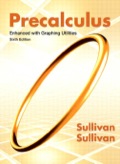
Concept explainers
How would you explain the Principle of Mathematical Induction to a friend?
To verify: The principle of Mathematical Induction to a friend.
Answer to Problem 34AYU
The assumption that the given statement is true for in this inductive step is called the inductive hypothesis.
Explanation of Solution
In mathematics, we use a form of complete induction called mathematical induction. To understand the basic principles of mathematical induction, suppose a set of thin rectangular tiles are placed as shown in the figure.

When the first tile is pushed in the indicated direction, all the tiles will fall. To be absolutely sure that all the tiles will fall, it is sufficient to know that
a. The first tile falls, and
b. In the event that any tile falls its successor necessarily falls.
This is the underlying principle of mathematical induction.
We know, the set of natural numbers N is a special ordered subset of the real numbers. In fact, N is the smallest subset of with the following property:
A set is said to be an inductive set if and whenever . Since N is the smallest subset of which is an inductive set, it follows that any subset of that is an inductive set must contain N.
Example: Suppose we wish to find the formula for the sum of positive integers , that is, a formula which will give the value of when , the value , when and so on and suppose that in some manner we are led to believe that the formula is the correct one.
How can this formula actually be proved?
We can, of course, verify the statement for as many positive integral values of n as we like, but this process will not prove the formula for all values of n. What is needed is some kind of chain reaction which will have the effect that once the formula is proved for a particular positive integer the formula will automatically follow for the next positive integer and the next indefinitely. Such a reaction may be considered as produced by the method of mathematical induction
The Principle of Mathematical Induction
Suppose that the following two conditions are satisfied with regard to a statement about natural numbers:
CONDITION I: The statement is true for the natural number 1.
CONDITION II: If the statement is true for some natural number k, it is also true for the next natural number . Then the statement is true for all natural numbers.
Condition I is simply a statement of fact.
There may be situations when a statement is true for all . In this case, step 1 will start from and we shall verify the result for .
Condition II is a conditional property. It does not assert that the given statement is true for , but only that if it is true for , then it is also true for .
So, to prove that the property holds, only prove that conditional proposition: If the statement is true for , then it is also true for .
This is sometimes referred to as the inductive step. The assumption that the given statement is true for in this inductive step is called the inductive hypothesis.
Chapter 12 Solutions
EBK PRECALC.:ENHANCED W/GRAPH.UTIL.
Additional Math Textbook Solutions
Calculus & Its Applications (14th Edition)
Precalculus: Concepts Through Functions, A Unit Circle Approach to Trigonometry (4th Edition)
Single Variable Calculus: Early Transcendentals (2nd Edition) - Standalone book
Precalculus (10th Edition)
Calculus, Single Variable: Early Transcendentals (3rd Edition)
Precalculus
 Calculus: Early TranscendentalsCalculusISBN:9781285741550Author:James StewartPublisher:Cengage Learning
Calculus: Early TranscendentalsCalculusISBN:9781285741550Author:James StewartPublisher:Cengage Learning Thomas' Calculus (14th Edition)CalculusISBN:9780134438986Author:Joel R. Hass, Christopher E. Heil, Maurice D. WeirPublisher:PEARSON
Thomas' Calculus (14th Edition)CalculusISBN:9780134438986Author:Joel R. Hass, Christopher E. Heil, Maurice D. WeirPublisher:PEARSON Calculus: Early Transcendentals (3rd Edition)CalculusISBN:9780134763644Author:William L. Briggs, Lyle Cochran, Bernard Gillett, Eric SchulzPublisher:PEARSON
Calculus: Early Transcendentals (3rd Edition)CalculusISBN:9780134763644Author:William L. Briggs, Lyle Cochran, Bernard Gillett, Eric SchulzPublisher:PEARSON Calculus: Early TranscendentalsCalculusISBN:9781319050740Author:Jon Rogawski, Colin Adams, Robert FranzosaPublisher:W. H. Freeman
Calculus: Early TranscendentalsCalculusISBN:9781319050740Author:Jon Rogawski, Colin Adams, Robert FranzosaPublisher:W. H. Freeman
 Calculus: Early Transcendental FunctionsCalculusISBN:9781337552516Author:Ron Larson, Bruce H. EdwardsPublisher:Cengage Learning
Calculus: Early Transcendental FunctionsCalculusISBN:9781337552516Author:Ron Larson, Bruce H. EdwardsPublisher:Cengage Learning





